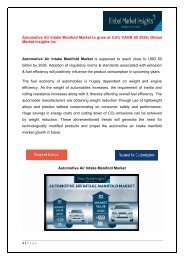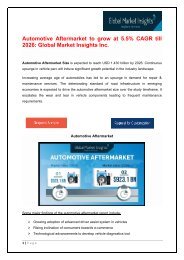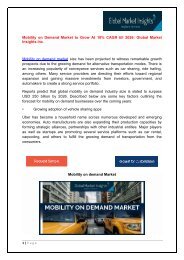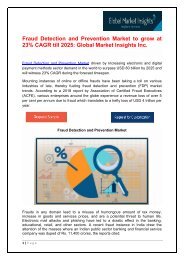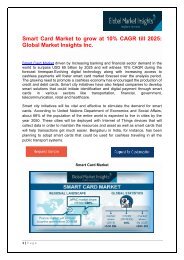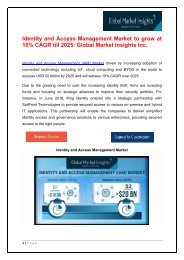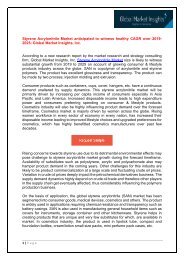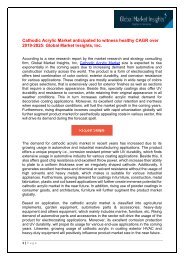Mobility on Demand Market Industry Share, Growth, Analysis, Statistics, Trends, Forecast Report, 2024
More Information @ http://bit.ly/2n9Iyue The integration of transit networks & operations, real-time data, and cooperative Intelligent Transportation Systems (ITS) allow for a more traveler-centric, transportation structure, providing improved mobility options to all users in an efficient and safe manner. Travel and mobility demands have evolved from private automobile ownership to more flexible, public, and private options, which incorporate shared-use and multimodal integration.
More Information @ http://bit.ly/2n9Iyue
The integration of transit networks & operations, real-time data, and cooperative Intelligent Transportation Systems (ITS) allow for a more traveler-centric, transportation structure, providing improved mobility options to all users in an efficient and safe manner. Travel and mobility demands have evolved from private automobile ownership to more flexible, public, and private options, which incorporate shared-use and multimodal integration.
You also want an ePaper? Increase the reach of your titles
YUMPU automatically turns print PDFs into web optimized ePapers that Google loves.
aut<strong>on</strong>omous vehicles are expected to change the mobility <strong>on</strong> demand market<br />
landscape as the need for drivers would have vanished. Fully automated vehicles have<br />
shown promise to revoluti<strong>on</strong>ize such transportati<strong>on</strong> systems. The growth in the userbase<br />
for ride-sharing and public-private partnerships provide abundant opportunities<br />
facilitating the growth of the MOD market.<br />
However, MOD market need further development al<strong>on</strong>gside existing services in an<br />
integrated fashi<strong>on</strong> to foster a smooth and c<strong>on</strong>nected transport system. The presentday<br />
transport system needs to be flexible and efficient.<br />
The high cost of infrastructure development, is a key factor restraining the growth of<br />
the MOD market. There is a restraint due to low internet penetrati<strong>on</strong> in developing<br />
regi<strong>on</strong>s. Although the government-provided incentives are in favor of the industry,<br />
regulatory policies c<strong>on</strong>tinue to remain stringent and abstruse, further hindering the<br />
industry growth. Resistance from traditi<strong>on</strong>al taxi services and c<strong>on</strong>tinued c<strong>on</strong>sumer<br />
usage of local transportati<strong>on</strong> services due to lack of trust in the mobility <strong>on</strong> demand<br />
market and its services may prove to be a challenge. Reliance <strong>on</strong> cloud computing<br />
also places the risk of privacy and data security as informati<strong>on</strong> about users and drivers<br />
are readily available <strong>on</strong> the app.<br />
Based <strong>on</strong> the type, MOD market includes E-hailing, car sharing, car rental, and stati<strong>on</strong>based<br />
services. The e-hailing service segment is anticipated to display the maximum<br />
growth as it offers first and last mile c<strong>on</strong>nectivity to passengers. It makes use of GPS<br />
to reduce the taxi waiting time and are predominant in urban parts. C<strong>on</strong>sumers have<br />
shown an inclinati<strong>on</strong> towards app-based e-hailing services owing to its focus <strong>on</strong> better<br />
customer service, innovative pricing system, and user-friendliness. The integrati<strong>on</strong> of<br />
traditi<strong>on</strong>al car rental model with car-sharing technology will open up new business<br />
opportunities for smaller car rental operators MOD market without the need of having<br />
to start a separate car-sharing company.<br />
With respect to segmentati<strong>on</strong> based <strong>on</strong> the vehicle type in the MOD market, electric<br />
vehicles are rapidly gaining popularity and are so<strong>on</strong> expected to compete with IC<br />
engine vehicles, which are currently dominating the mobility <strong>on</strong> demand market. Based<br />
<strong>on</strong> data services, it includes navigati<strong>on</strong>, informati<strong>on</strong>, and payment. The navigati<strong>on</strong><br />
service segment has the most significant demand. Payment service market is<br />
predicted to grow significantly in the MOD market over the forecast period. Service<br />
providers in this industry make use of payment gateways for <strong>on</strong>line payment<br />
processing. Payments in foreign currency and internati<strong>on</strong>al expansi<strong>on</strong> by MOD service<br />
providers will increase the growth of the payment services. Navigati<strong>on</strong> service is<br />
predicted to be a major shareholder in the industry demand over the future as both<br />
drivers and passengers use it. MOD segmentati<strong>on</strong> by Internet and vehicle c<strong>on</strong>nectivity<br />
comprise 3G, 4G, Wi-Fi, and V2V, V2P, V2I, and V2N.<br />
Asia Pacific regi<strong>on</strong>, which c<strong>on</strong>tains numerous emerging ec<strong>on</strong>omies with massive<br />
populati<strong>on</strong> bases; for instance, China and India are the most lucrative areas in the<br />
MOD market. Various app-based car sharing and taxi services have proliferated the<br />
regi<strong>on</strong>. Stati<strong>on</strong>-based mobility, government incentives, and an increase in supporting<br />
infrastructure will also aid the growth in the Asia Pacific market. Factors, such as rising<br />
2 | P a g e





